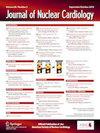The impact of attenuation correction and prone positioning on stress-only imaging in cardiac SPECT: An observational study
IF 2.7
4区 医学
Q2 CARDIAC & CARDIOVASCULAR SYSTEMS
引用次数: 0
Abstract
Background
Current guidelines recommend stress-only single photon emission computed tomography myocardial perfusion imaging (SPECT MPI) in select patients to reduce time, cost, and radiation. However, stress-only imaging remains underutilized.
Objectives
We assessed techniques to increase the adoption of stress-only SPECT MPI, specifically evaluating whether prone positioning and CT-based attenuation correction (AC) reduce the need for additional rest imaging.
Methods
Consecutive patients with normal stress SPECT MPI scans were included. The need for additional rest imaging was assessed according to the use of prone positioning and AC. Radiotracer dose was calculated per the institution's protocol and compared between groups. Survival analysis compared the safety of stress-only protocols to stress-rest protocols.
Results
Between 2018 and 2024, 14,274 patients with no stress perfusion defects were included. The use of stress-only imaging increased from 43.6% among patients with neither AC nor prone to 63.4% with AC and 65.7% with prone to 76 % with both techniques. Using multivariable logistic regression, the simultaneous use of prone and AC techniques significantly increased stress-only imaging (OR: 5.0, 95% CI: 4.38-5.72). This was more pronounced among females, obese patients, patients >65 years, and patients with an EF ≥ 55%. Radiotracer dose dropped by 35.6% when both AC and prone were used. Patients with normal stress-only SPECT scans had similar prognoses to those with normal SPECT scans using both stress and rest images, regardless of AC or prone imaging use.
Conclusion
Combined use of AC and prone reduces the need for rest imaging by nearly half and lowers radiotracer doses by a third. Benefits are more pronounced in women, the elderly, patients with obesity, non-diabetics, and those with preserved ejection fraction.

衰减校正和俯卧位对心脏SPECT应力成像的影响:一项观察性研究。
背景:目前的指南推荐在特定的患者中使用仅应力单光子发射计算机断层扫描心肌灌注成像(SPECT MPI)来减少时间、成本和辐射。然而,压力成像仍然没有得到充分利用。目的:我们评估了增加仅应力SPECT MPI采用的技术,特别是评估了俯卧定位和基于ct的衰减校正(AC)是否减少了额外的休息成像需求。方法:连续接受正常应激SPECT MPI扫描的患者。根据俯卧定位和AC的使用评估额外休息成像的需要。根据机构的方案计算放射性示踪剂剂量,并在组间进行比较。生存分析比较了仅应激方案与应激休息方案的安全性。结果:2018年至2024年,纳入无应激灌注缺陷患者14274例。单纯压力成像的使用从无AC或易感患者的43.6%增加到AC患者的63.4%,易感患者的65.7%增加到两种技术的76%。使用多变量逻辑回归,同时使用俯卧和AC技术显著增加了仅应力成像(OR: 5.0, 95% CI: 4.38-5.72)。这在女性、肥胖患者、bb0 ~ 65岁患者和EF≥55%患者中更为明显。放射示踪剂剂量在AC和俯卧组均下降35.6%。仅进行正常应激SPECT扫描的患者与同时使用应激和休息图像进行正常SPECT扫描的患者预后相似,无论使用AC或俯卧成像。结论:AC和俯卧联合使用可减少近一半的休息成像需求,降低三分之一的放射性示踪剂剂量。在女性、老年人、肥胖患者、非糖尿病患者和保留射血分数的患者中,效果更为明显。
本文章由计算机程序翻译,如有差异,请以英文原文为准。
求助全文
约1分钟内获得全文
求助全文
来源期刊
CiteScore
5.30
自引率
20.80%
发文量
249
审稿时长
4-8 weeks
期刊介绍:
Journal of Nuclear Cardiology is the only journal in the world devoted to this dynamic and growing subspecialty. Physicians and technologists value the Journal not only for its peer-reviewed articles, but also for its timely discussions about the current and future role of nuclear cardiology. Original articles address all aspects of nuclear cardiology, including interpretation, diagnosis, imaging equipment, and use of radiopharmaceuticals. As the official publication of the American Society of Nuclear Cardiology, the Journal also brings readers the latest information emerging from the Society''s task forces and publishes guidelines and position papers as they are adopted.

 求助内容:
求助内容: 应助结果提醒方式:
应助结果提醒方式:


